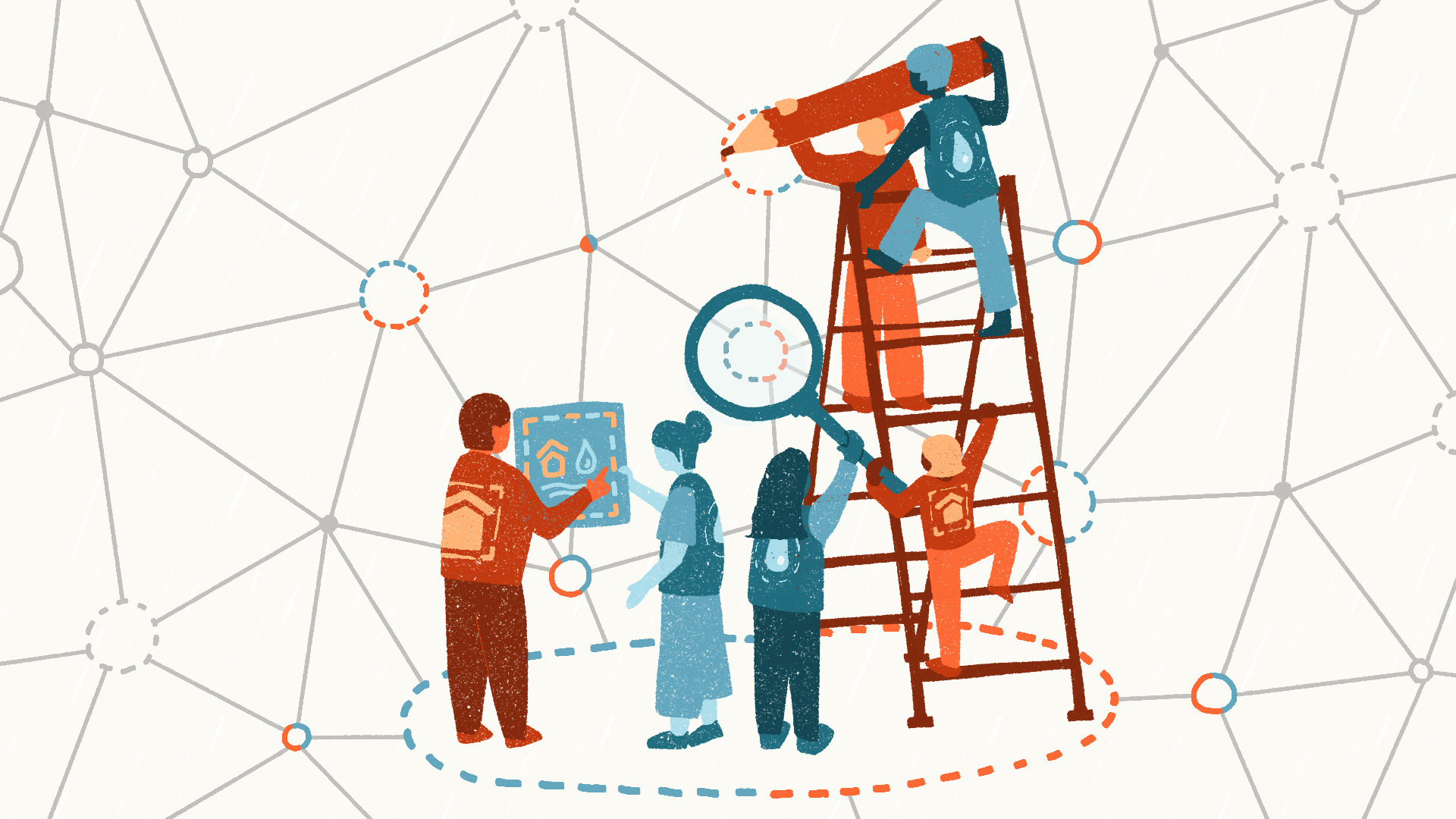
Unpacking the challenges
What is bringing housing and water together?
Systemic risks such as extreme weather patterns, loss of biodiversity, relentless resource depletion, economic inequality and lack of affordable housing – just to name a few – affect every industry. These growing interconnected risks and liabilities cannot be addressed and managed by siloed thinking and isolated operations. They are an opportunity for collaborative action that unlocks cost efficiencies and maximises benefits.

Impacts of the polycrisis
In recent years, we have witnessed the emergence of a complex and interwoven phenomenon known as the polycrisis, where multiple global risks create a compounding effect, such that their overall impact exceeds the sum of their individual parts.
Climate change, for example, is triggering an increase of extreme weather events such as floods and heatwaves. This adds extra pressure on our water-related infrastructure and homes located in vulnerable places and limits the opportunity for resilient housing and thriving local economies.
Additionally, the construction of cities and towns transform the natural landscape drastically: vegetation and soil are replaced with hard, impermeable surfaces and buildings. This results in the development of unique urban climates that are notably distinctive from those of surrounding natural environments. Common consequences are an increase in air pollution, flash floods and higher air temperatures.
"In the future we will face similar challenges with water that we are currently seeing with energy, but we won't have the same solutions.
Our water is a finite resource."

Building a mutual understanding of each sectors’ challenges
Our world’s polycrisis affects every sector, however it can manifest differently in each sector, giving rise to specific challenges for each.
There are many specific challenges facing the water and housing sector and due to their systemic, interconnected nature, there might be challenges which are currently unknown to us or may change over time in unpredictable ways.
It is important to build a mutual understanding of each sectors’ challenges and learn more about key sector actors and their motivations, limitations, capabilities and actions. Doing so allows us to foster collaboration between the water and the housing sector. It helps us to identify new shared challenges as well as to discover where one sector’s action in solving their challenge may trigger an unprecedented challenge for another sector.
Examples of sector specific challenges:
Water Sector
Increase in water scarcity due to changing patterns of precipitation and a high degree of uncertainty
Increase in flooding due to climate change, insufficient infrastructure capacity and urbanisation
Challenge meeting water quality targets due to nutrient neutrality requirements, sewer overflows and run-off
A lack of awareness, incentives and shared value around water impacts customer behaviours and limits innovation
Balancing competing demands such as asset investment versus customer bills
Biodiversity net gain targets and net zero carbon targets
Deteriorating, ageing assets and lock-in to traditional infrastructure solutions
Inadequate funding and governance models for management of green-blue infrastructure
Public trust and customer buy-in
Changing political and policy context, for example environmental regulations surrounding nutrient neutrality or DWI rules wholesome water impacting innovation around reuse
Housing Sector
Increasingly ambitious housing targets – pressure on local authorities to deliver
Lack of affordable housing
Underfunding of the planning system is delaying housing delivery and capacity
Unambitious housing design standards –reliance on market-driven innovation
Pressure on land availability due to flood risk and environmental management, and new issues such as nutrient neutrality, land-banking and high land value.
Difficulties capturing land value uplift – need new models for transferring value to support place-based outcomes
Biodiversity net gain targets
Scaling innovation and alternative housing delivery models, such as community-led housing
Long-term management of shared assets such as public realm
Rapidly changing political leadership, and regulatory/legislative environment, for example potential changes to leasehold impacting certain stewardship models

Paving the way for collaboration
Today there is an increased number of challenges in which both the water and housing sector have a stake. As the challenges facing the water and housing sectors are becoming increasingly intertwined, so does the responsibility of managing these risks collectively. Siloed thinking and isolated operations are reaching their limitations and are not producing the right solutions to be resilient and future-proof.
We need to embrace the interconnectedness of our world and use it to our advantage identifying connections, allies and leverage points. It is crucial to go beyond a shared awareness of mutual interests and overcome the preconceived boundaries that can limit true partnership across sectors. We need to challenge conventional practices in favour of more dynamic and collaborative ways of responding to contemporary, complex challenges.
Collaboration can transform these shared risks into opportunities for innovation and action, unlocking new value for both for sector actors and the communities they serve.
From risks to opportunities:
Cascading Risk
e.g. Extreme weather pattern, growing population, urbanisation, increasing inequality
Shared Risks
e.g. Long-term stewardship of assets, flood risk and nutrient neutrality, competing demands for land
e.g. Global warming, pandemic, economic crises
Systemic Risk
Opportunities
Areas of collaborative action where innovation unlocks new value for all stakeholders.
Examples of key shared challenges:
Water Sector
Housing Sector
Water quality
Flood risk
Water scarcity
Affordability
Balancing customer and community expectations
Long-term stewardship of assets
Shared funding and finance models
Competing demands for land
Biodiversity and net zero carbon

Unlocking new shared value
The EWSC project invites us to see interdependency as an opportunity for cross-sector collaboration and new value creation. By embracing the complexity in which we operate, we can identify connections, allies and leverage points.
Cross-sector collaboration allows us to use differences as a catalyst to design robust and sustainable solutions in partnership with the communities most impacted by the challenges. Together, we can develop innovative ways of partnership working, explore new joint ventures, governance structures and funding models that generate wider benefits for everyone involved.
"Bringing in new coalitions of actors to overcome siloes in design opens an opportunity to learn about joined-up approaches to resolving challenges."
Claire Hoolohan & Ella Foggitt, University of Manchester
Further Resources
Explore our research findings through our publication series
Discover further EWSC resources















